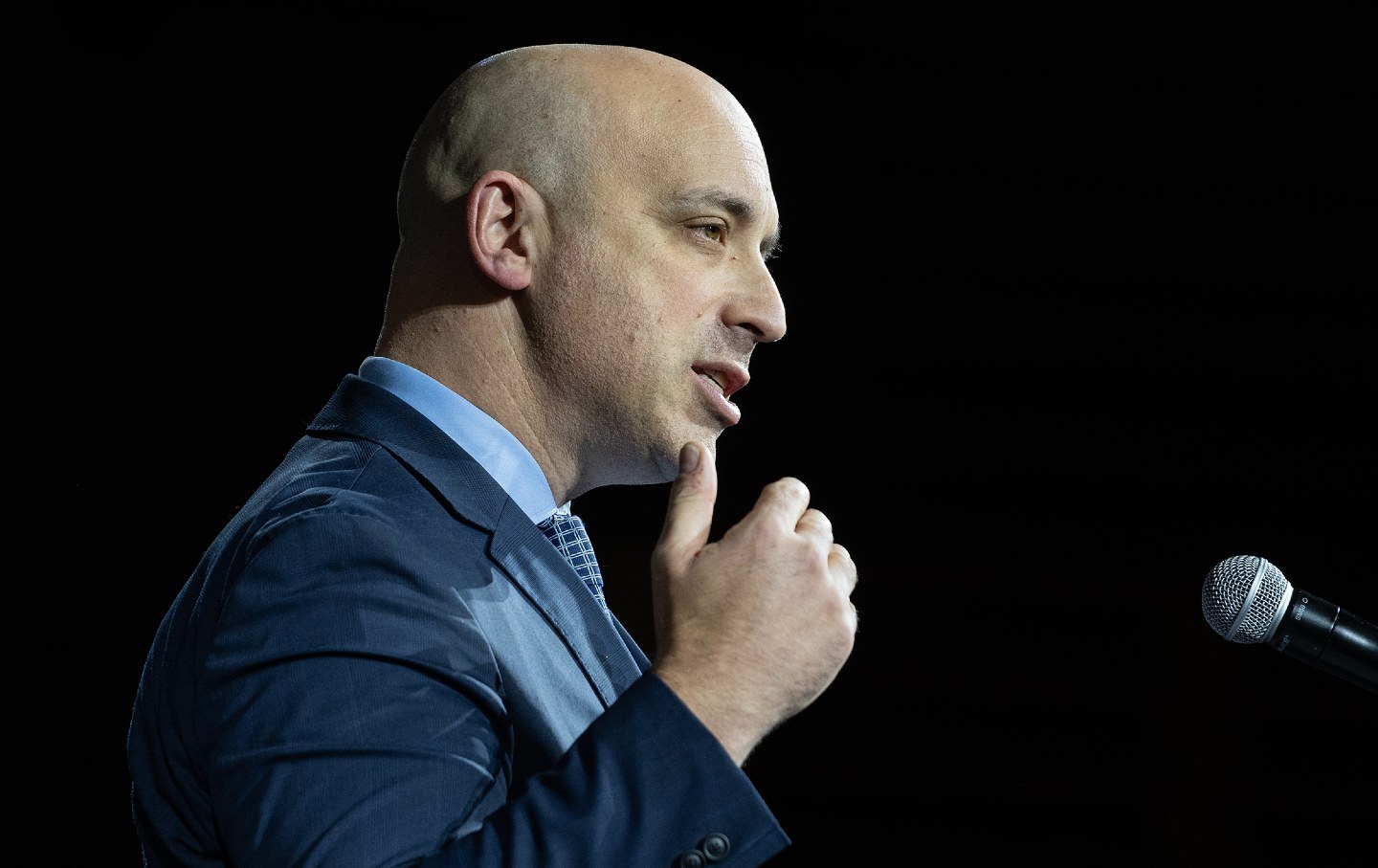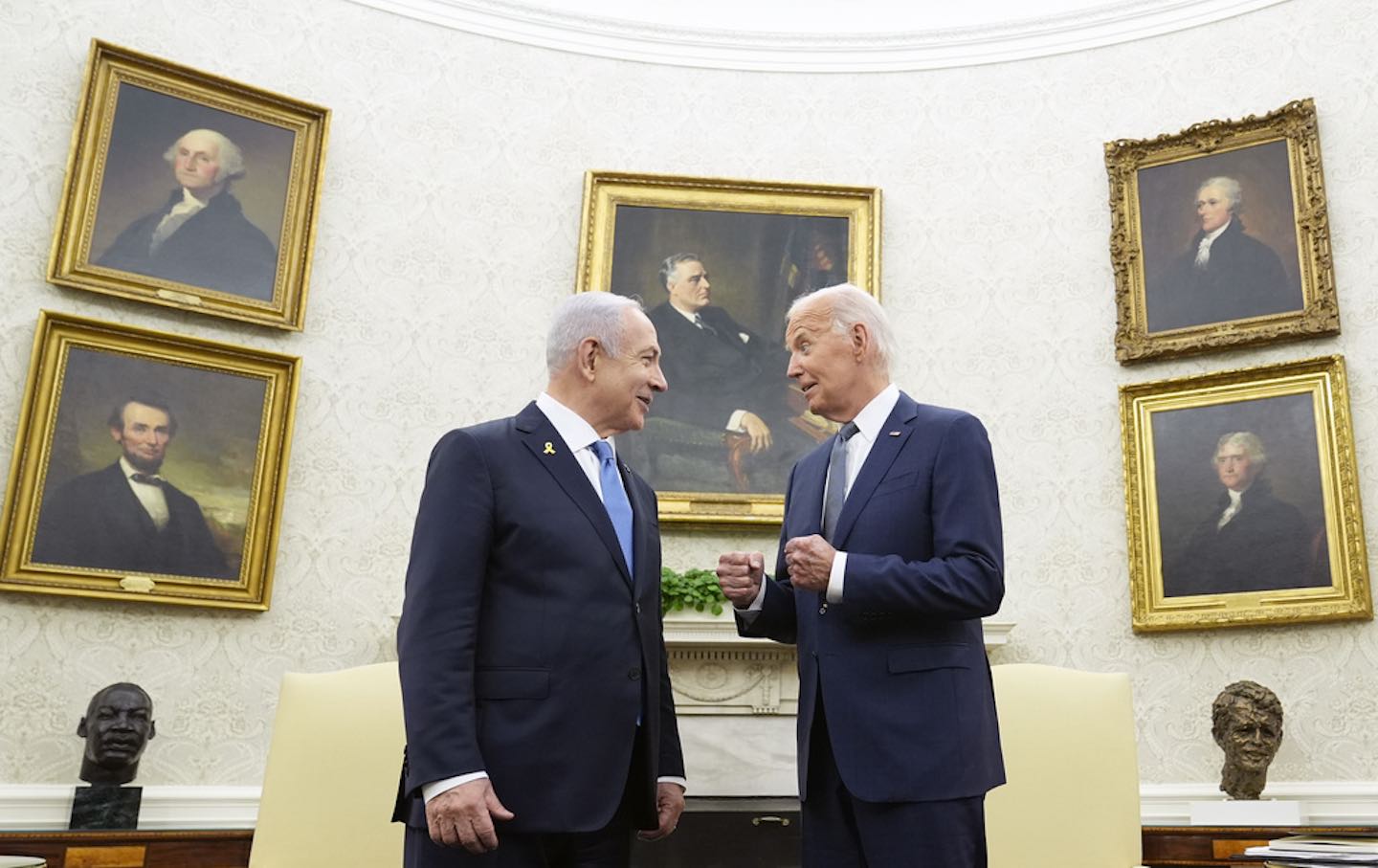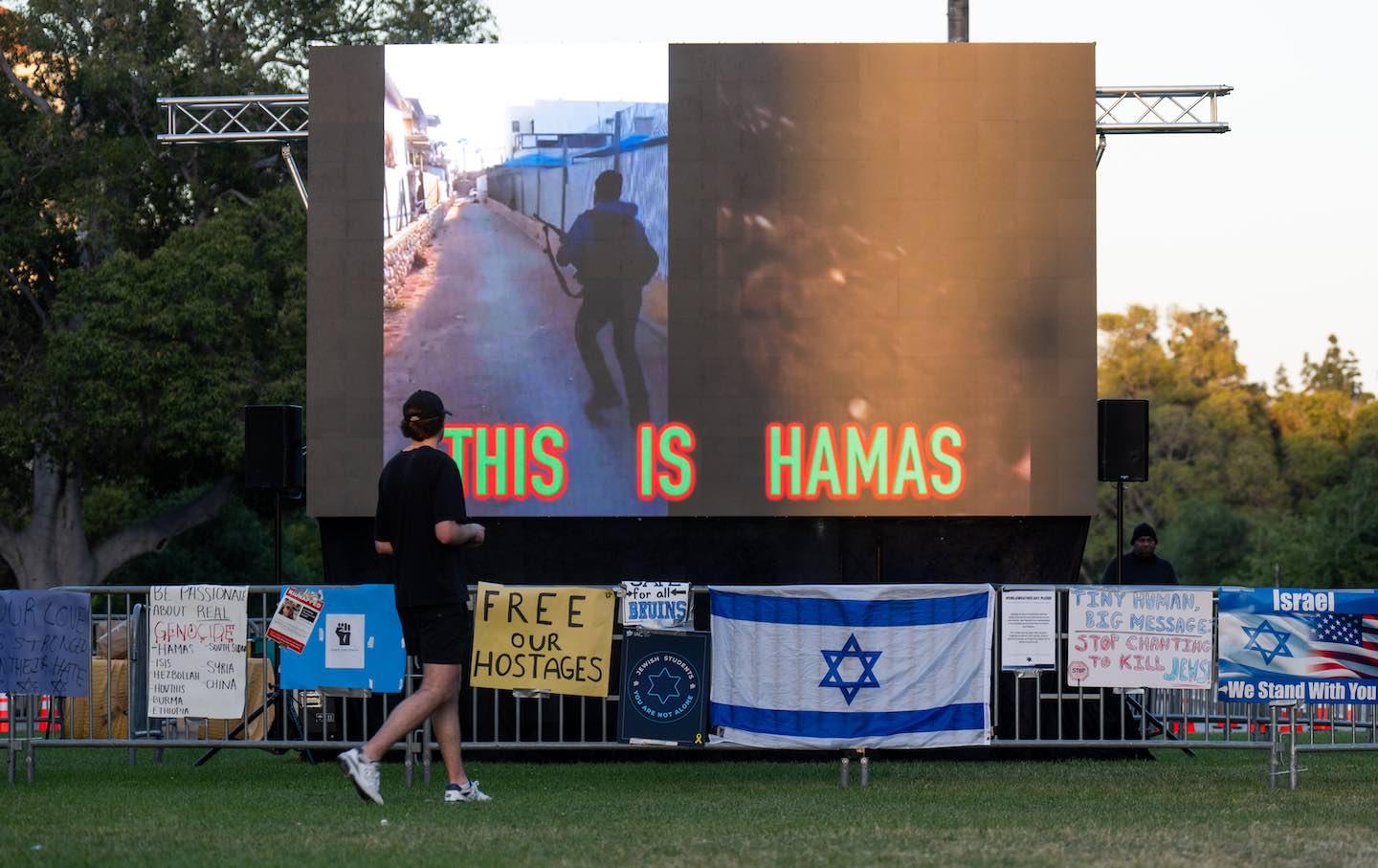The Anti-Defamation League: Israel’s Attack Dog in the US
Posing as a civil rights group, the ADL has long operated as an intelligence organization targeting Israel’s critics. So why does the media still treat it as a credible source?

At about $60 a square foot, the 44-story skyscraper at 605 Third Avenue is one of the priciest office buildings in Manhattan. And standing at the plate-glass window of his 73,000-square-foot headquarters Jonathan Greenblatt knows the value of projecting an image of wealth and power. On the street far below the director of the Anti-Defamation League are his targets: Americans who need to be educated and informed as to the growing dangers of antisemitism throughout the country, whether in schools, at work, or in the community.
And for Greenblatt, the best way to get that message out is by working closely with the friendly mainstream press, who typically accept the ADL’s data and press releases at face value. After all, the ADL—founded in 1913 in the wake of the controversial murder conviction of Leo Frank, who was later lynched by a Georgia mob in 1915—has been around a long time, and has always had very close relations with Congress, the White House, and the rest of the Washington establishment.
On January 9, for example, a few weeks after a large pro-Palestinian demonstration in New York City, Greenblatt released a report listing over 3,000 antisemitic incidents committed in the three months since the war in Gaza began. “U.S. Antisemitic Incidents Skyrocketed 360% in Aftermath of Attack in Israel,” warned the ADL press release. “The American Jewish community is facing a threat level that’s now unprecedented in modern history,” said Greenblatt. “It’s shocking.” As expected, the ADL report drew media coverage around the country. “Antisemitic incidents in the U.S. surged after October 7 Hamas attack, advocacy group says,” ran an NBC News headline. Similar titles headed stories by The Hill, Axios, CNN, and many other sources.
But much of the report was hype. Rather than attacks against Jews due to their religious or ethnic identity, many of the cited “incidents” were actions directed against Israel to protest the conduct of its war in Gaza—incidents the ADL would later admit made up nearly half of the total. “Overall, a large share of the incidents appear to be expressions of hostility toward Israel, rather than the traditional forms of antisemitism that the organization [ADL] had focused on in previous years,” noted Arno Rosenfeld in The Forward. Many of the incidents were simply protests by civil rights organizations such as Students for Justice in Palestine.
Earlier this month, a number of former ADL staffers confided to Jewish Currents “that in the past months, Greenblatt has redirected the ADL’s day-to-day work to target pro-Palestine activism rather than focusing on antisemitism in American life, a shift they say seriously undermines the organization’s credibility.” Another was quoted saying that Greenblatt is “waging war on pro-Palestinian activists,” while a third asserted that “there are a lot of people of all political stripes at ADL who believe what Jonathan is doing is reprehensible.” According to the magazine, Greenblatt has even battled against the ADL’s own civil rights office over legislation targeting criticism of Israel, “choosing repeatedly to privilege Israel advocacy over the protection of civil liberties.”
Even before the war in Gaza, there had been concern by many progressive organizations about the legitimacy of the ADL’s alarmist claims regarding antisemitism. In 2020, more than 100 such groups, including the Center for Constitutional Rights and the Movement for Black Lives, signed a “#DropTheADL” open letter requesting that members of the progressive community not partner with the ADL. The organization, it said, “has a history and ongoing pattern of attacking social justice movements led by communities of color, queer people, immigrants, Muslims, Arabs, and other marginalized groups, while aligning itself with police, right-wing leaders, and perpetrators of state violence.”
The problem is that The New York Times, PBS, and other mainstream outlets that reach millions are constantly and uncritically promoting the ADL and amplifying the group’s questionable charges. At the same time, they regularly fail to inform their readers, viewers, and listeners either about the organization’s current shift towards silencing Israel’s critics or its long history of deception, lying, and corruption—including covert operations and illegal spying on innocent Americans. A greater awareness of this history—and of the ADL’s ongoing attempts to silence critics of the war in Gaza via slanderous and often untrue charges—might suggest that, instead of simply repeating those charges, a less-credulous media might want to examine the group’s long-standing (but carefully hidden) links to the Israeli government. And whether the ADL’s spying and covert operations are really all in the past.
For much of its history, the ADL has operated in the United States as if it were a hostile intelligence organization—which, in essence, it was. The organization’s spymaster was Irwin Suall, who from the 1960s to 1997 ran his nationwide network of agents and informants from the ADL’s New York City headquarters. As millions of dollars in donations flowed into the “civil rights” organization, tens of thousands of dollars flowed out to Suall’s clandestine operatives in the field, actively engaged in violating the civil rights of thousands of Americans. Among his agents was Roy Bullock, a beefy San Franciscan with the codename “Cal” who posed as a small-time art dealer in the Castro District and spied undercover in the US for the ADL. To hide the ADL’s involvement, Bullock’s payments were laundered through a Beverly Hills attorney who, Bullock would later tell authorities, never missed a payment in more than three decades. Bullock said he would submit his reports to the ADL’s executive director in San Francisco, Richard Hirschhaut, now the regional director of the American Jewish Committee for Los Angeles.
A July 1992 internal ADL memo from Suall praised Bullock as “our number one investigator.” It would eventually be discovered his network of spies secretly collected information on more than 12,000 individuals and more than 950 American religious, labor, peace, and human rights groups. His targets included the NAACP, the Rainbow Coalition, ACLU, ACT UP, the American Indian Movement, Greenpeace, the Northern California Ecumenical Council, the United Farm Workers, reporters from the Los Angeles Times and KQED public television, and at least eight Jewish peace groups, as well as an assortment of pro-Palestinian organizations. A key target was the American-Arab Anti-Discrimination Committee.
Working clandestinely with Bullock was Thomas Gerard, a detective with the San Francisco Police Department’s Intelligence Unit, and a three-year veteran of the CIA. Gerard would illegally supply Bullock with confidential data from police and FBI computer files about Americans, many of them pro-Palestinian activists, that were targets of the ADL. Eventually, investigators would discover that Gerard kept files on 7,011 people.
Bullock and Gerard also targeted Americans on behalf of the apartheid government of South Africa—an extremely close ally of Israel at the time. Bullock and Gerard would meet clandestinely with agents from the brutal and notorious Bureau of State Security (BOSS), including one using the name “Humphries,” in the Travelodge motel in San Francisco’s Fisherman Wharf area. “Humphries said he was interested in acquiring information on anti-apartheid activities in the United States,” Bullock later confessed to the FBI agents, as well as “any sexual impropriety” they could dig up on the well-known anti-apartheid activist Bishop Desmond Tutu. Even details about members of Congress—including House Armed Services Committee Chairman Ron Dellums, a powerful critic of the South African government—were passed on by the ADL agents to BOSS.
The ADL’s spying operations began to unravel in October 1992, when Detective Gerard was brought into the FBI’s San Francisco office for questioning. Shortly thereafter, to avoid arrest, he fled to Palawan, a remote jungle island in the Philippines that had no extradition treaty with the United States. At the time, I was the Washington investigative producer for ABC News, and after discovering where Gerard was hiding, I flew to Palawan along with a colleague, James Walker. When we arrived, Gerard agreed to an interview, in which he admitted knowing Bullock but denied giving him the confidential police files, even though Bullock had already confessed to the FBI and many of the documents were recovered.
We also interviewed David Gurvits, the ADL’s former operative in Los Angeles, who told us that he informed authorities that his job was to collect information—some of it illegal—and to maintain files on thousands and thousands of people. “Other codenames for other investigators included Flipper, Chi-1, Chi-3, Chi-2,” he told us. “Flipper,” it turns out, was the codename for an ADL operative who worked out of the organization’s Atlanta office. Chi-1, 2, and 3 worked out of the ADL’s Chicago office. Gurvits told investigators with the San Francisco Police Department that the ADL kept records on any Arab-American who had “anti-Israel leanings” or wrote a letter to a newspaper expressing such feelings. Just as today, criticism of Israel—not antisemitism—was the ADL’s true concern.
Popular
“swipe left below to view more authors”Swipe →The investigation also clearly showed how closely the ADL and its spying operation collaborated with the Israeli government and its intelligence organizations. According to court documents, “Bullock and/or Hirschhault admitted that ADL or its agents gave information to the Government of Israel.” Also, Suall “had met with the Israeli intelligence officials in Israel.” And in an interview with the FBI, a former employee of the Los Angeles ADL office “provided confirmation of direct, regular contacts between employees of the ADL and Israeli officials.” Bullock, according to the reports, “also testified to the FBI that the ADL paid for Gerard to fly to Israel,” likely to also meet with senior Israeli intelligence, military and political officials. Palestinians and Arab-Americans in the United States were the main targets of the spying.
And it turns out the ADL had been spying in the US and passing the data to the Israeli government for a very long time. “[T]he Anti-Defamation League for many years has maintained a very important, confidential investigative coverage of Arab activities and propaganda,” said a 1961 internal ADL document. “Our information, in addition to being essential for our own operations, has been of great value and service to both the United States State Department and the Israeli Government. All data have been made available to both countries with full knowledge to each that we were the source.” It would seem, therefore, that ADL’s intelligence gathering activities against American citizens have long been well known to Washington.
Exposing this secret and long-standing collaboration between the ADL and Israel, with the US fully on board, would have been deeply embarrassing to both countries. Israel, therefore, may have attempted to quickly shut it down. According to a secret March 29, 1993, FBI memorandum, “SFPD [The San Francisco Police Department] has received information from a reliable source that two persons, described as ‘Israeli generals,’ are in, or are about to travel to, Washington, D.C., in regard to captioned matters [i.e., the ADL case]. The purpose of their travel is to try to visit the attorney general, to press for an end to the FBI’s investigations concerning [redacted] and [redacted] [likely Bullock and Gerard]. According to the SDPD, the FBI’s investigation of these matters are causing a great deal of interference in the U.S. activities of the Anti-Defamation League of B’nai B’rith (ADL), and so Israel is seeking to intercede on the ADL’s behalf.”
The FBI quickly dropped the case and washed its hands of it—as it does with virtually all cases involving Israel. That left prosecution to the San Francisco district attorney’s office which, armed with a search warrant, carried out a surprise raid on the ADL’s San Francisco office on April 8, 1993. Local television stations aired video of investigators lugging out evidence boxes full of files. But in the end, the DA’s office also wanted to drop the political hot potato. Thus, the DA agreed to forgo prosecution of the ADL and Bullock in exchange for a pledge not to engage in improper information gathering activities—i.e., spying—in California. And a payment of up to $75,000 to fight hate crimes, which is what they were supposed to have been doing all along. Because the FBI refused to provided documents in his case, Gerard was allowed to plead no contest to the lesser charge of illegal access to a police computer system. He was sentenced to three-years of probation, 45 days on the sheriff’s work crew, and a $2,500 fine.
With barely a slap on the wrist, and a wink from Washington, the ADL continued as if nothing had happened, even continuing to employ its star spy Bullock. At the time the spying was exposed, the head of the organization was Greenblatt’s immediate predecessor, Abraham Foxman—known in the community as the “Jewish pope” because of his power, having served as president for 28 years until his retirement in 2015. The ADL board did not dump Foxman after the embarrassing spy scandal; instead, the organization greatly rewarded him: in addition to being kept on for another decade, he received a $1.5 million retirement package above and beyond his salary. And at his retirement party, then–Vice President Joe Biden—who received more pro-Israel cash than any other member of Congress—sang “Happy Birthday” to Foxman. All of which sent a clear message to Greenblatt that no matter what his organization does, Washington will happily close its eyes. The ADL’s priority today remains—as it has for decades—going after Americans who are simply opposed to Israel’s endless occupation and oppression of Palestinians. The group’s preferred targets are students, professors, activists, and demonstrators—rather than antisemites, especially those on the far right. But the group’s reckless bullying ought to also act as a wake-up call to the media to take a closer look at the ADL’s long history of corruption, spying, and covert links to Israel before blindly publishing the next breathless handout.
We cannot back down
We now confront a second Trump presidency.
There’s not a moment to lose. We must harness our fears, our grief, and yes, our anger, to resist the dangerous policies Donald Trump will unleash on our country. We rededicate ourselves to our role as journalists and writers of principle and conscience.
Today, we also steel ourselves for the fight ahead. It will demand a fearless spirit, an informed mind, wise analysis, and humane resistance. We face the enactment of Project 2025, a far-right supreme court, political authoritarianism, increasing inequality and record homelessness, a looming climate crisis, and conflicts abroad. The Nation will expose and propose, nurture investigative reporting, and stand together as a community to keep hope and possibility alive. The Nation’s work will continue—as it has in good and not-so-good times—to develop alternative ideas and visions, to deepen our mission of truth-telling and deep reporting, and to further solidarity in a nation divided.
Armed with a remarkable 160 years of bold, independent journalism, our mandate today remains the same as when abolitionists first founded The Nation—to uphold the principles of democracy and freedom, serve as a beacon through the darkest days of resistance, and to envision and struggle for a brighter future.
The day is dark, the forces arrayed are tenacious, but as the late Nation editorial board member Toni Morrison wrote “No! This is precisely the time when artists go to work. There is no time for despair, no place for self-pity, no need for silence, no room for fear. We speak, we write, we do language. That is how civilizations heal.”
I urge you to stand with The Nation and donate today.
Onwards,
Katrina vanden Heuvel
Editorial Director and Publisher, The Nation








